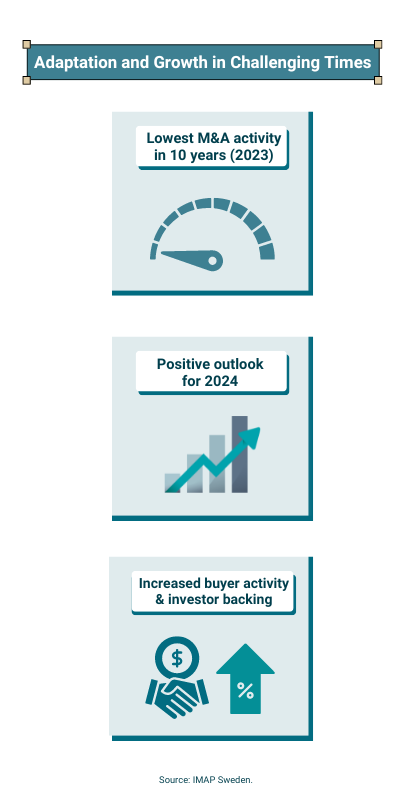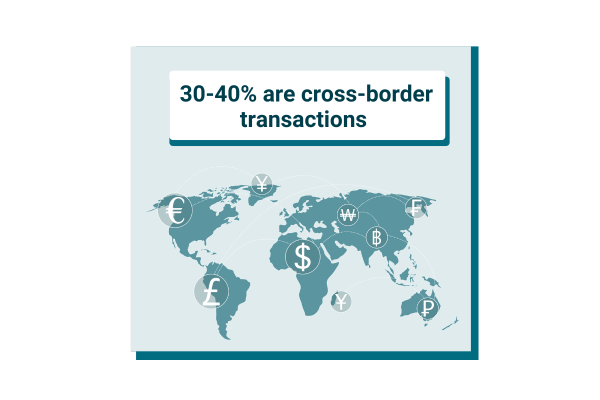Spotlight on the Swedish M&A Market
Sweden’s strong economy and stable regulatory environment have long attracted foreign investors to M&A opportunities. The transaction market reached historic highs in 2021 and early 2022, driven by several parameters working together: moderate inflation, strong economic growth, high corporate profits, and most importantly, many years of low interest rates.
Although the current M&A market growth rate is less than in previous years, according to recent statistics from Dealogic, 355 transactions were closed in Sweden in the first six months of 2024, with a total deal value of €13.8 billion. We predict seven key trends driving which will continue to drive deal activity in the Swedish M&A market.

1. Resilient M&A Activity
M&A activity in Sweden was at its lowest in 10 years in 2023, a trend reflected in other Nordic countries. However, despite challenging times, acquisitions have continued to take place and the outlook for 2024 is good with many different types of buyers now homing in on the mid-market. On a wider scale this shows that Nordic companies can quickly adapt to new economic conditions.
Buyer activity is increasing, and at IMAP Sweden we have been contacted by several newly established investment companies, some of which with prominent investor backing. Whether the significant increase will come as early as Q3 remains to be seen. However, considering the number of mandates we signed during the spring and will market externally after the summer, there is a very clear increase in activity, at a level we haven't experienced in a long time.
2. Smaller, More Strategic Transactions
Recent higher interest rates have increased the risks associated with large transactions; therefore, companies have focused on smaller deals. These acquisitions offer a balanced approach, reduced financial risk, yet take advantage of market opportunities, reflecting a cautious yet opportunistic approach to M&A.
3. Strategic Discipline in Transactions
We have observed a growing emphasis on a disciplined approach to M&A, focusing on robust due diligence and strategic financial management. This trend reflects the market's shift towards prioritizing long-term value and strategic fit over short-term profits. This also means that transactions tend to take a little longer today than they did a few years ago.
4. ESG & Digitization at the Forefront
Buyer’s M&A strategies are increasingly turning towards initiatives focused on digital transformation and ESG. This trend highlights the importance of sustainability and technological progress in shaping corporate agendas and M&A activities. Regulatory changes and focus on the UN's global goals for sustainable development - Agenda 2030 are also compounding this effect.

5. International Transactions
The percentage of cross-border transactions rebounded post pandemic to between 30 and 40% of all M&A transactions. Buyers are often motivated by taking advantage of this quick way to diversify internationally, add new customers and product areas, and combine know-how.
6. Consensus in Price Expectations
As the market stabilizes, the gap in pricing expectations between buyers and sellers has narrowed. This convergence allows more deals to proceed, facilitating negotiations and increasing the chances of closing.
7. Lots of Dry Powder on the Market
Many financial buyers have raised new funds that must now be invested. The acquisition conglomerates have strong cash flows and want to acquire new companies with this capital. Over the last few years, several new buyers have been established, both financial and acquisition conglomerates, with a focus specifically on the middle market.
With these positive trends, we expect a strong second half this year for M&A in Sweden. Factors such as falling inflation and lower interest rates continue to underpin growth. Which will also be powered both by strategic investment and sound business expansion decisions.
Overall, we are seeing a growing sense of optimism in the market, and in Private Equity in particular, with many players under pressure to put the capital in their new funds to work. In terms of transactions, we expect most of them to involve essential ESG elements, as well as focus on digital transformation through AI.
